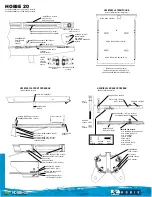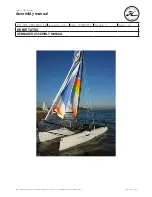
57
ELECTRICAL SYSTEM
6.1 General
Your boat is equipped with a 12 volt DC electrical
system and could be equipped with an optional
trolling battery charging system. The 12 volt DC
system draws current from two onboard batteries.
Boats equipped with the optional trolling motor will
also have a 36 volt DC electrical system dedicated
to the trolling motor. The 36 volt system draws
current from three onboard batteries that are com-
pletely isolated from the boat’s 12 volt system.
The boat engine charging system is designed for
12 volt, lead acid wet cell or AGM (Absorbed Glass
Matt) marine batteries. They will require similar
maintenance as those found in automobiles.
All wires in the electrical system are color coded to
make identifying circuits easier. Wiring schemat-
ics have been included with this manual to aid in
following an individual circuit of the boat.
6.2 Boat DC System Overview
The 12 volt system is a standard marine system.
There are two batteries located in the center con-
sole. They are controlled by a battery selector
switch and charged by the engine.
Most 12 volt power is distributed to the 12 volt
accessories through individual circuit breakers
located in the 12 volt switch panels. A main helm
circuit breaker located in the battery switch panel
protects the system from an overload. Other cir-
cuit breakers located in the battery switch panel
protect the circuits for the bilge pump automatic
float switch, the stereo and other accessories not
protected by circuit breakers in the switch panels.
Most 12 volt accessories are operated directly by
switches in the helm accessory switch panel, T-
Top switch panel or separate accessory switches.
Main breakers or fuses located on the engine
protect the ignition systems and gauges. Yamaha
engine electrical circuits are protected by fuses
located in a fuse panel on the side of the engine.
The fuse panel is equipped with a spare fuse for
each circuit. Always replace fuses with the fuse
specified by Yamaha or your engine manufacturer.
Refer to the engine owner’s manual for more
Chapter 6:
information on the fuses, fuse panels or circuit
breakers on your engines.
CAUTION
PROPER FUSE OR BREAKER PROTECTION MUST BE
PROVIDED FOR ALL 12 VOLT EQUIPMENT ADDED. DO NOT
OVERLOAD THE ACCESSORY CIRCUIT BREAKERS OR OTHER
CIRCUITRY THROUGH ADDITIONAL 12 VOLT EQUIPMENT.
6.3 Batteries & Battery Switch
The DC electrical system on your boat is designed
for wet cell or AGM marine batteries. You should
not mix the size or brand of wet cell or AGM bat-
teries. Always consult your Crevalle dealer before
changing the type of batteries in your boat.
Your boat has provision for two batteries. These
batteries should be of the size and capacity rec-
ommended by the manufacturer of your engine.
See the engine owner’s manual. These specifi
-
cations should be considered to be the minimum
size battery required. Consider increasing the
capacity of the battery if you will be trolling, drift
fishing or have extensive electronics onboard.
Larger batteries will give you additional capacity
to operate the baitwells, release wells, washdown,
electronics and other 12 volt accessories at low
speed when the charging system output of the
engine is minimal.
The battery selector switch is located in a panel
below the helm. The switch feeds the engine and
the 12-volt accessory panel. The engine battery
switch is a dual circuit switch that has three posi-
tions, OFF, ON and COMBINE BATTERIES. When
the battery switch is in the ON position, the engine
and accessory circuits are activated simultane-
ously and current flows from the batteries to the
engine, accessories and electronics. The dual
circuit sensing feature in the switch allows the
engine battery and circuit to be completely sepa-
rate from the accessory battery and circuit. The
COMBINE BATTERIES (EMERGENCY PARALLEL
ONLY) position is highlighted in yellow and used
to temporarily connect both batteries in parallel to
provide additional starting power in the event of
a low or dead engine starting battery. Once the
engine is started, the switch should be moved to
Summary of Contents for 24 Bay
Page 1: ...Owner s Manual 24 26 Bay...
Page 2: ...2 Revision 0 11 17 2015...
Page 14: ...14 NOTES...
Page 20: ...20 NOTES...
Page 23: ...23 Operation...
Page 36: ...36 NOTES...
Page 52: ...52 NOTES...
Page 68: ...68 NOTES...
Page 78: ...78 NOTES...
Page 100: ...100 NOTES...
Page 110: ...110 NOTES...
Page 116: ...116 NOTES...
Page 117: ...117 SCHEMATICS Appendix A CV 004 Hardtop Panel Rev B...
Page 118: ...118 Schematics CV 005 Console Harness Rev E...
Page 119: ...119 Schematics CV 006 Deck Harness Rev F...
Page 120: ...120 Schematics CV 007 Helm Switch Panel Command Link Plus...
Page 121: ...121 Schematics CV 009 Hardtop Rev C...
Page 122: ...122 NOTES...
Page 123: ...123 24 Bay Designated Occupant Positions X X X X X X X X Occupant Seating Appendix B...
Page 124: ...124 Occupant Seating 26 Bay Designated Occupant Positions X X X X X X X X X...
Page 129: ...129 MAINTENANCE LOG Appendix D Hours Date Dealer Service Repairs...
Page 130: ...130 Maintenance Log Hours Date Dealer Service Repairs...
Page 131: ...131 Maintenance Log Hours Date Dealer Service Repairs...
Page 132: ...132 Maintenance Log Hours Date Dealer Service Repairs...
Page 133: ...133 Maintenance Log Hours Date Dealer Service Repairs...
Page 134: ...134 Maintenance Log Hours Date Dealer Service Repairs...
Page 135: ...135 Appendix E BOATING ACCIDENT REPORT...
Page 136: ...136 Boating Accident Report...
Page 137: ...137 Boating Accident Report...
Page 138: ...138 NOTES...
Page 140: ...140 NOTES...
Page 145: ...CAUSE AND SOLUTION...
Page 146: ......
Page 147: ...Crevalle Boats Littoral Marine LLC 1520 Industrial Drive Wildwood FL 34785...
















































